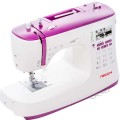Max. presser foot height
It is the distance from the work surface to the presser foot in the highest position. It must be taken into account when working with thick fabrics.
Sewing speed
The maximum sewing speed provided by the sewing machine. In the vast majority of models, this parameter can be adjusted, so that, if necessary, you can sew at a lower speed.
The more stitches per minute the machine makes, the higher its productivity, and the better it is suitable for large volumes of work. At the same time, note that high speed has a corresponding effect on price and power consumption, and it is not always required. Detailed recommendations on choosing the optimal speed for certain types of work can be found in special sources.
Presser foots
Types of presser feet supplied with the sewing machine.
— Universal foot. A foot is used for standard sewing, mainly straight stitches and zigzags.
—
Overlock foot. A foot designed for overlocking. By definition, it is found in devices with an overlock function (see “Type”). However, it can also be provided in traditional sewing machines. In the latter case, such a foot, of course, will not replace a full-fledged overlocker, but in some situations it allows you to work without it.
—
Top feed or walking foot. An additional top-mounted feed dog in place of the stock foot, in addition to the standard bottom feed dog. Such a device makes it easier to work with thin, delicate and sliding fabrics, as well as sewing together several layers of fabric: the material moves as evenly as possible, without distortions and displacements.
—
Zipper foot. The foot for sewing in a zipper can have a different size and design — in particular, there are special devices for sewing in a hidden zipper. The specific features of this device should be clarified separately.
—
Decorative stitch foot. Feet designed for various types of decorative stitching. Such a line may not have a functional role. Its main task is to emphasize a certain element of clothing (edges, pockets, individual seams, etc.). Anyway, the stit
...ch line should usually strictly follow the contour along which it is applied — and this contour can consist of both straight lines and curved lines. Special feet for decorative stitching simplify the task: they are equipped with rulers or other devices that allow you to control the parallelism of the stitches.
— Satin stitch foot. This foot will be suitable for appliqué and other work where zigzag stitches are often used.
— Blind hem foot. Foot designed for blind seams used when hemming the edge of the fabric. It is equipped with a device that provides a hem of the fabric and in this position feeds it under the needle.
— Quilting foot. Special feet for quilting — patchwork. In such works, it is necessary to sew the fabric in several layers, as well as to perform figured seams. In extreme cases, you can use the usual universal foot for quilting, but using a special device is still much more convenient.
— Monogramming foot. The foot for embroidery of monograms will allow you to make embroidery on any object, thereby decorating it with your signature or the emblem of any institution, company, or sports club.
— Buttonhole foot. Buttonhole foot. It eliminates the need for manual work. The sewing machine will do everything for you, which will reduce your time and please you with quality.
— Button sewing foot. A foot is designed to hold the button on the fabric while sewing on. It has a special protrusion pointing down: when the main part of the foot is pressed against the button, this protrusion presses the fabric and prevents it from slipping.
In addition to the above, other types of feet may be included in the delivery kit.Custom stitches
Возможность
создания собственных типов строчки и сохранения их в памяти швейной машинки. Конкретный способ создания может быть разным: в одних моделях для этого нужно воспользоваться компьютером и загрузить готовые настройки в машинку, другие позволяют сделать все на самой машинке, без дополнительного оборудования. В любом случае данная функция дает пользователю дополнительную свободу творчества; особенно она полезна для тех, кто планирует часто пользоваться нестандартной строчкой.
Cover
The type of cover supplied with the sewing machine.
-
Soft. A soft fabric cover protects the machine mainly from dust and dirt and provides almost no protection from bumps and collisions. At the same time, having removed such a cover for the duration of work, it can be folded compactly.
-
Hard. A cover in the form of a hard cover put on from above or a case in which the machine fits. Such a cover is rather bulky, it cannot be folded like a soft one; on the other hand, it protects the machine well both from dirt and from collisions and contact with solid objects.

